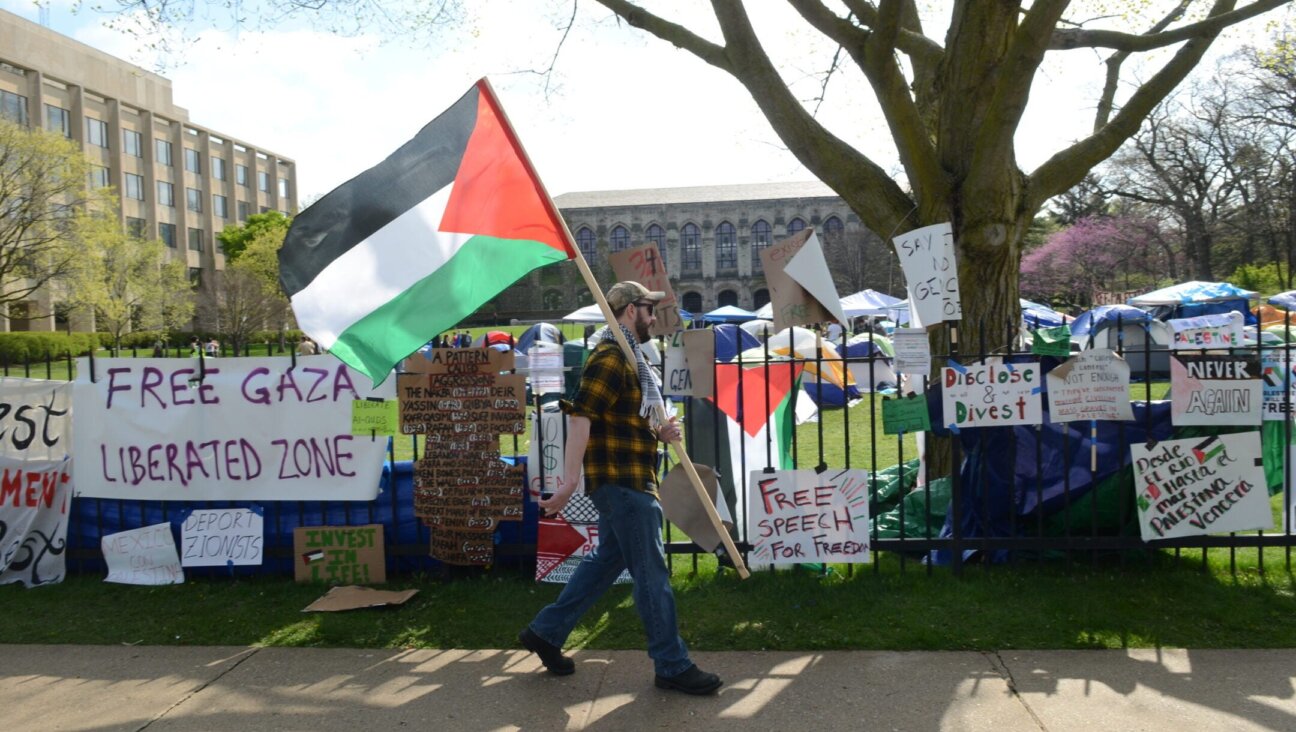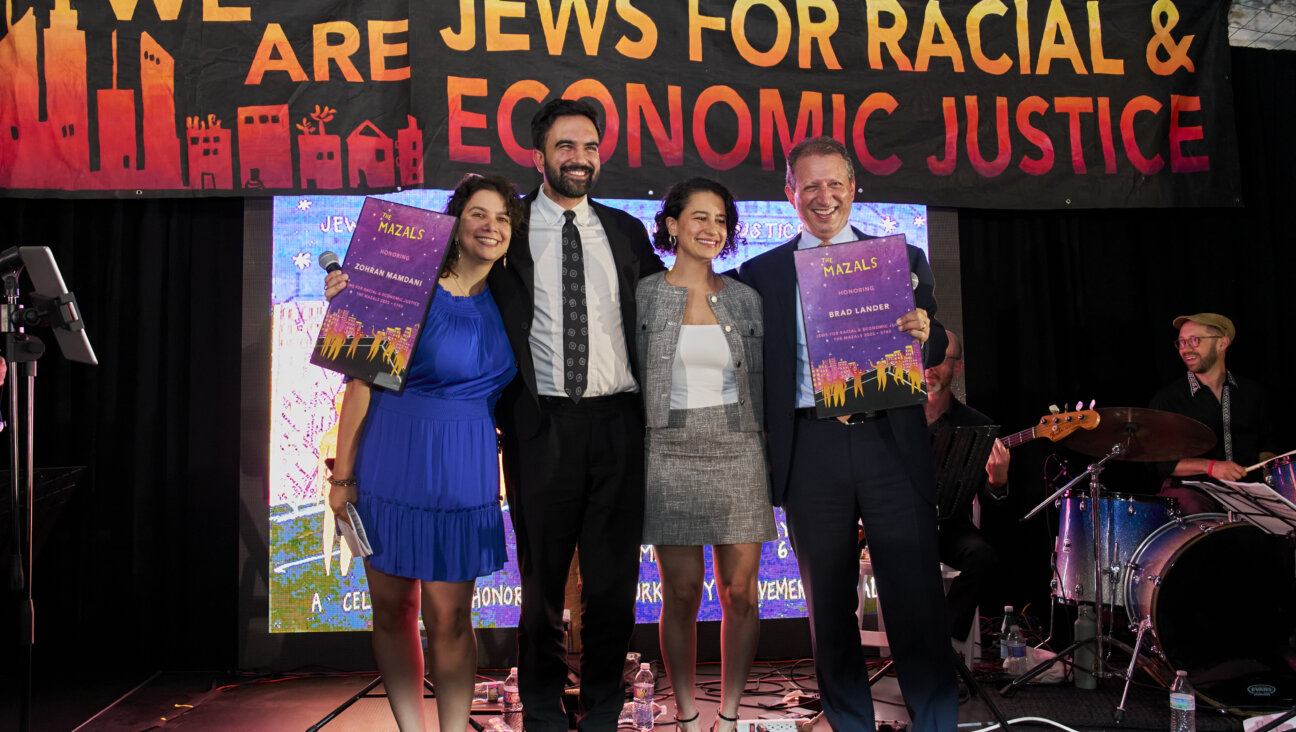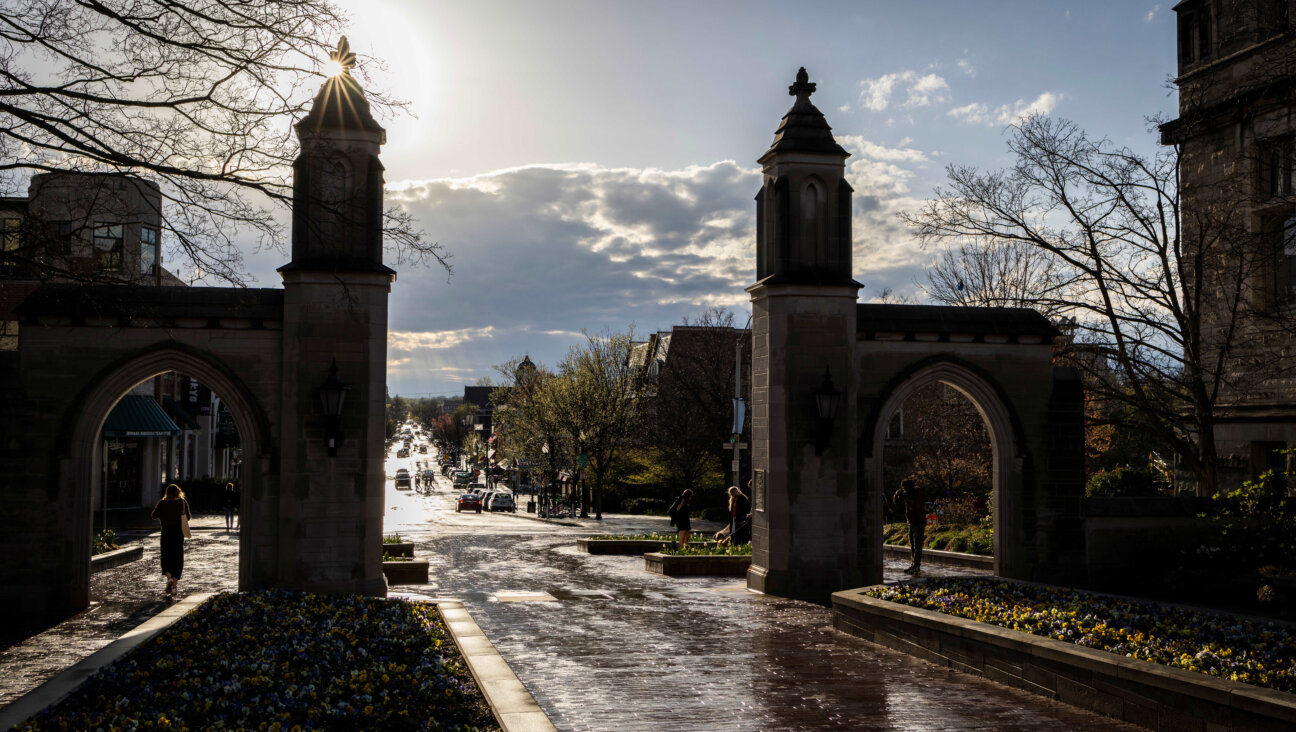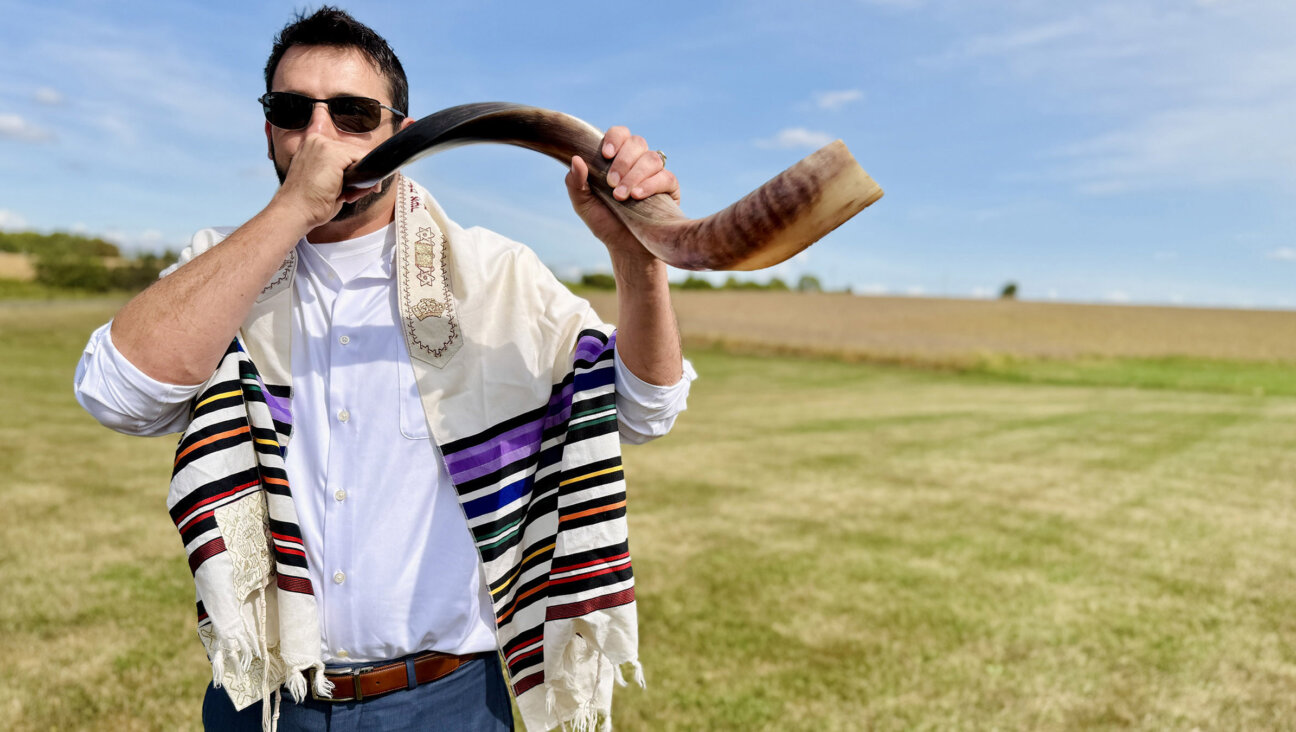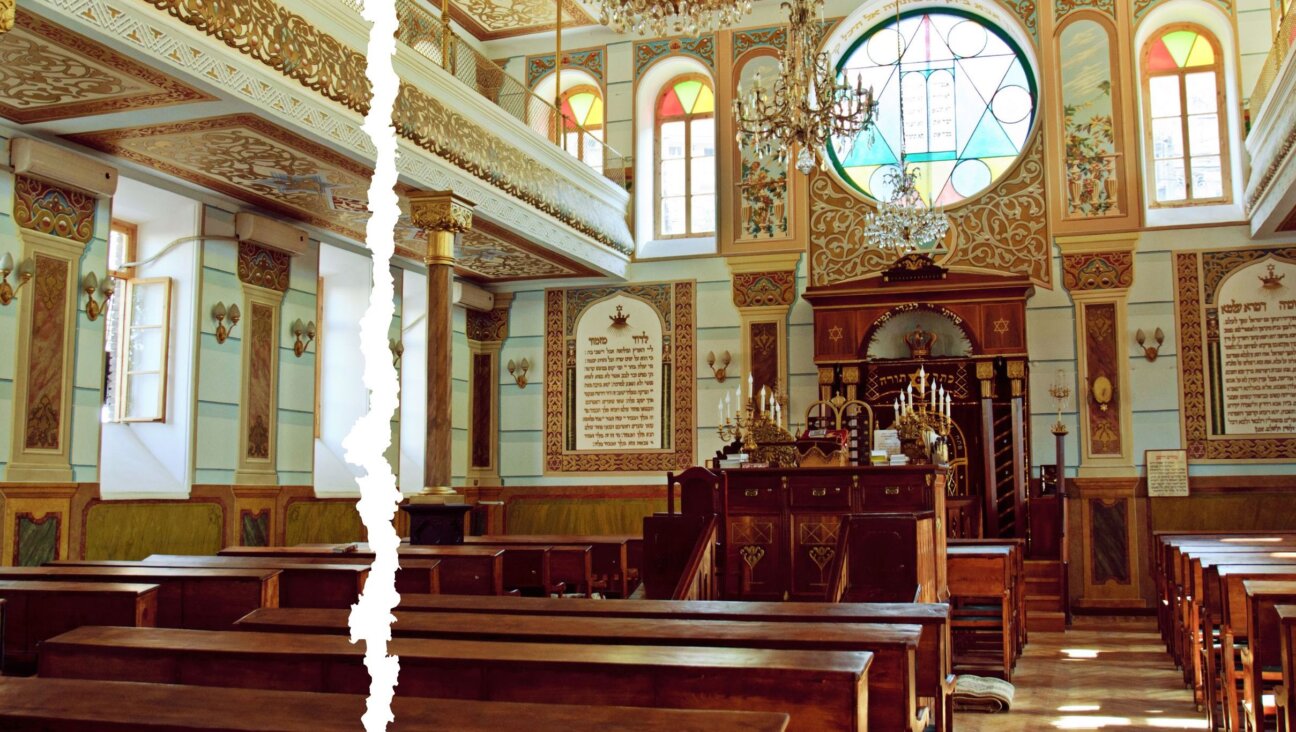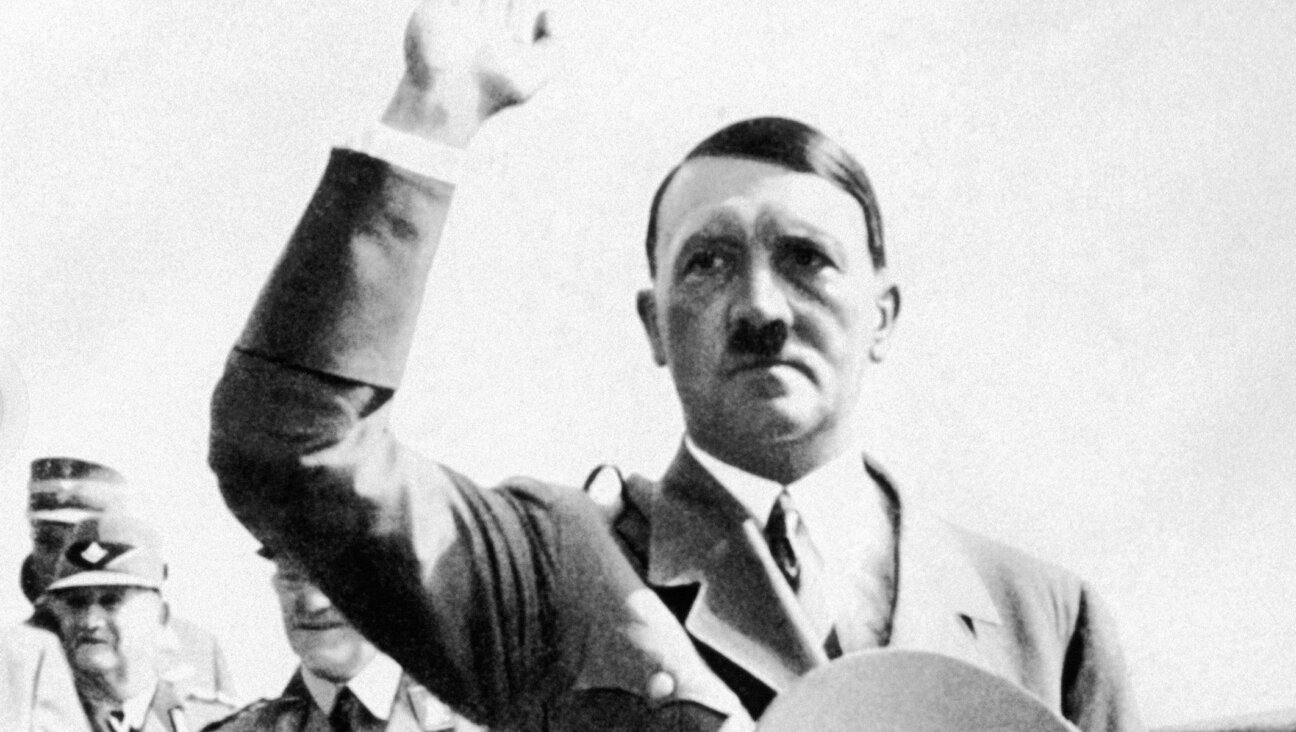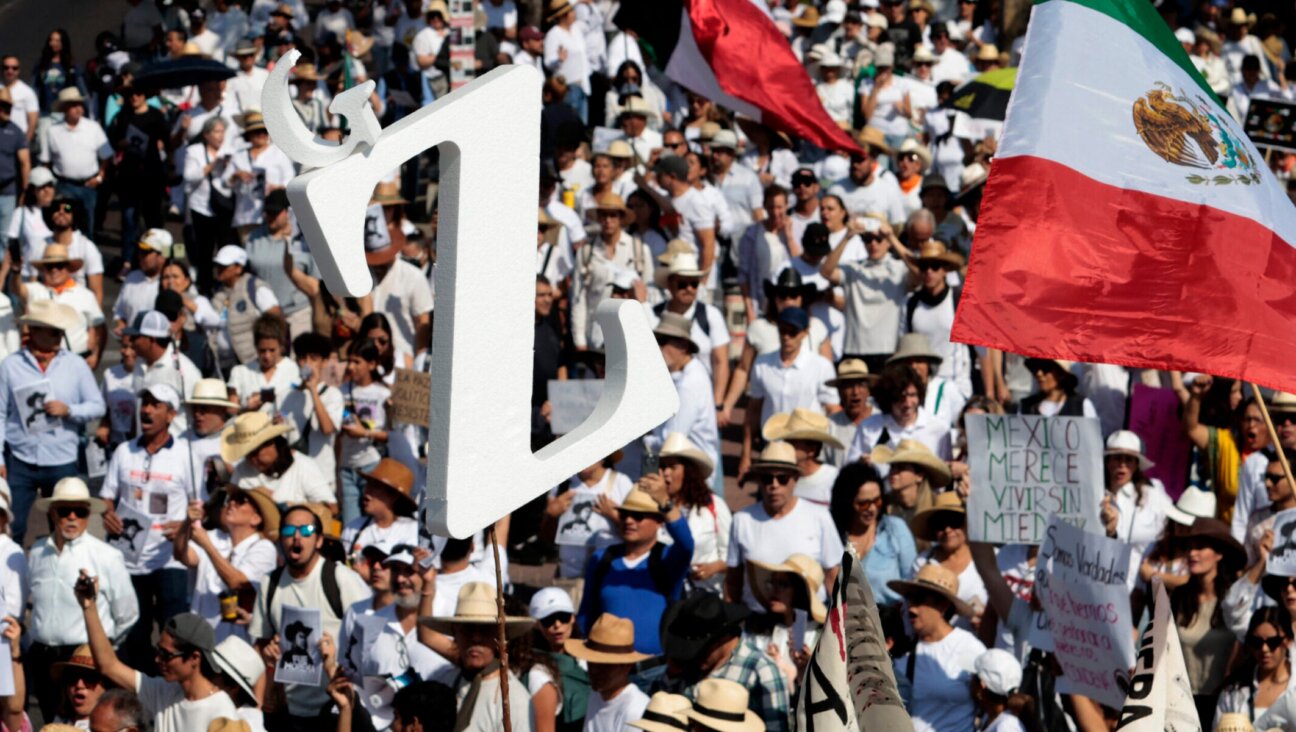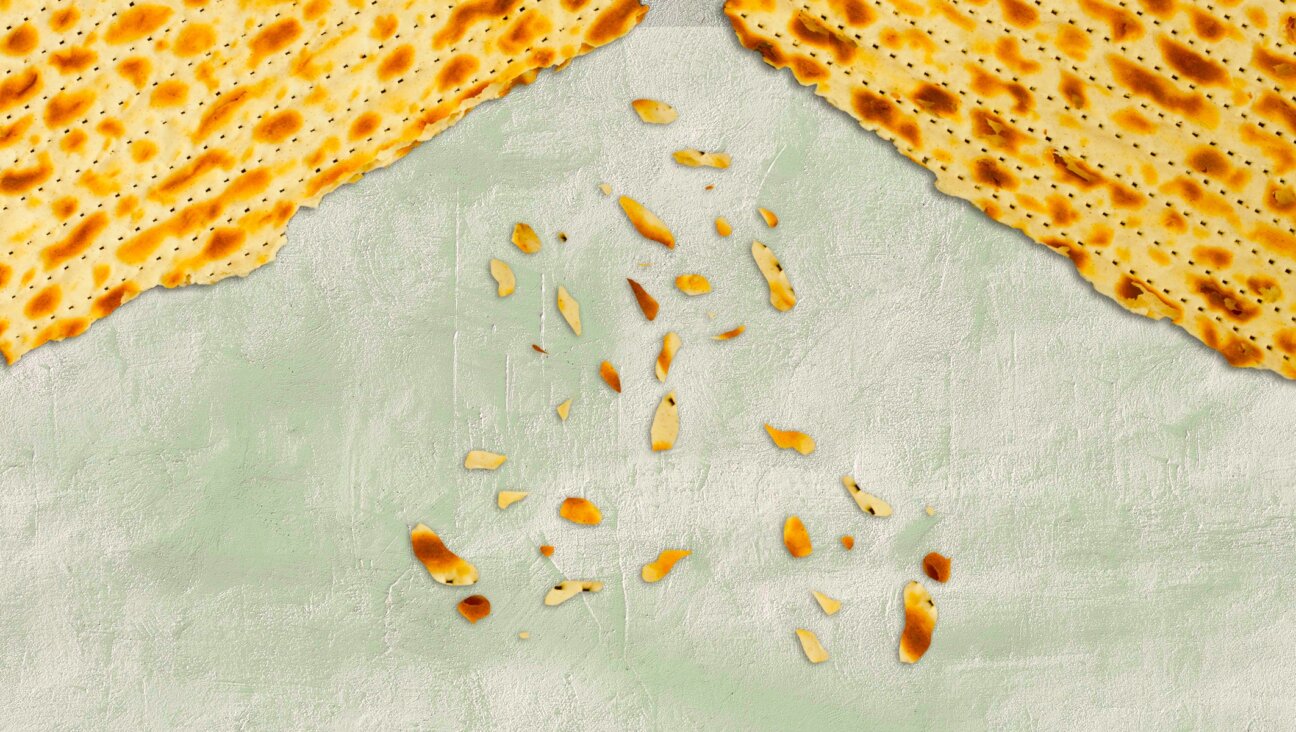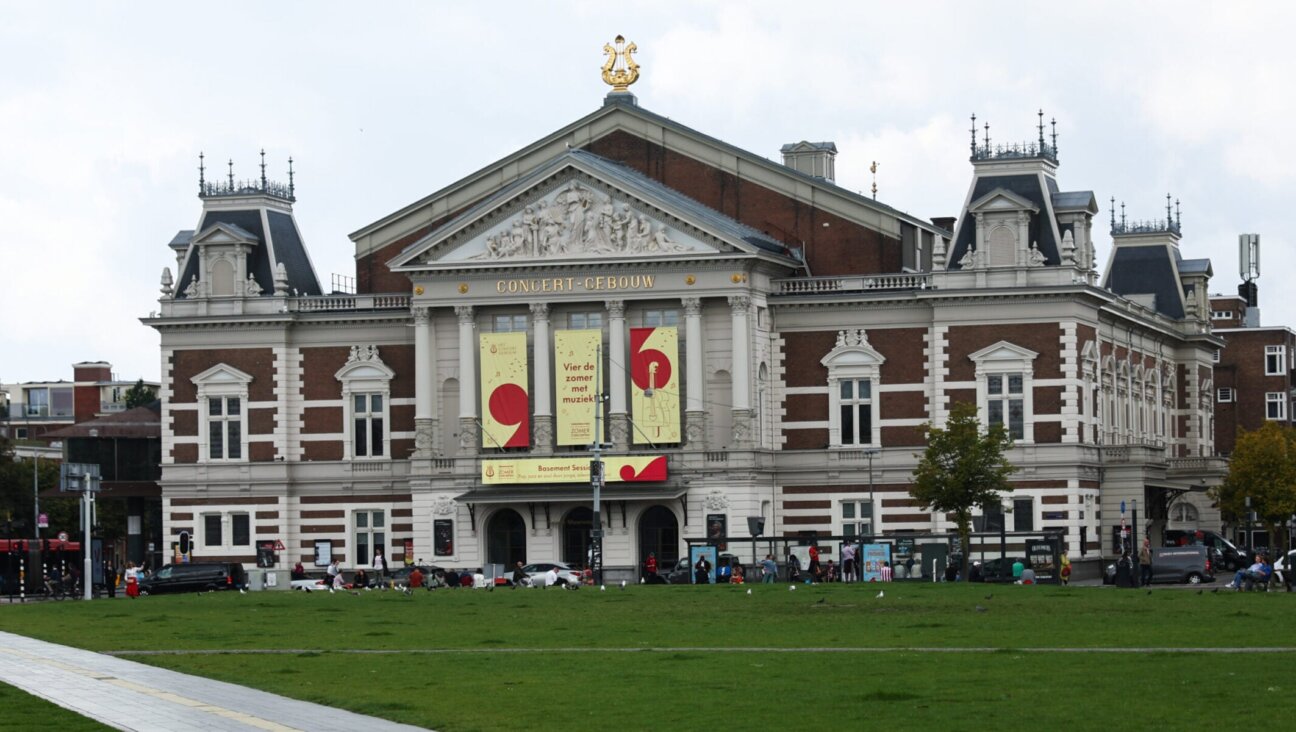Literary Stars Learn ‘Occupation 101’ Firsthand in Tense Tour of West Bank

Image by Oren Ziv/Activestills
The American writer Ayelet Waldman was on a tour near the Hamra checkpoint, deep inside the Palestinian West Bank, when a silver car with Israeli plates pulled over. The driver, an Israeli Jew, got out and began taking photos of Waldman’s tour group, which included the Austrian author Eva Menasse and Pulitzer Prize-winning novelist Geraldine Brooks, as well as a bevy of photographers and anti-occupation activists.
In another setting, the Israeli driver might have been a fan of, say, Brooks’ most recent novel, “The Secret Chord,” about the life of King David. But it was clear that he had no idea whom he was photographing, only that he meant to intimidate the group. “What are you doing?” Menasse said, notebook in hand, as he held his camera phone in front of her face. “Taking your picture,” he said. “You’re not the only ones who can walk around with cameras.”

From left: Authors Helon Habila, Michael Chabon, Ayelet Waldman and Dave Eggers in the Palestinian village of Nabi Saleh. Image by Oren Ziv/Activestills
The interaction was par for the course for the wild West Bank, where settlers are known to confront Palestinian rights activists. But it’s not every day that some of the most acclaimed novelists in the world find themselves caught up in a flashpoint of the Israeli occupation.
The authors’ visit to the Hamra checkpoint was part of a weeklong tour of the West Bank by Breaking the Silence, the controversial Israeli group that collects and distributes testimonies of soldiers who served in the occupied territories. In addition to Waldman, Menasse and Brooks, several other literary stars attended the tour: American novelists Dave Eggers, Rachel Kushner and Michael Chabon (Waldman’s husband and a Pulitzer Prize winner) and Nigerian author Helon Habila. More than a dozen other writers will be taking similar trips in the coming months in research for an upcoming book of essays.
It was a hot afternoon at the Hamra checkpoint, at the base of a sloping red hill in the Jordan Valley, and the writers had taken shade in an empty concrete bus depot when the Israeli man stopped by. Waldman introduced herself to him in Hebrew, clearly less ruffled by the interloper than the others. “I’m Ayelet,” she said. “What’s your name, cutie?” She followed him back to his car, and took a photo of him taking a photo of her. Then he gave her the double finger, and got into his car and drove away. Waldman soon posted a picture of him on Twitter to her 14,500 followers with his parting message to the group, finishing his sentence for him: “‘I would line you up by the side of the road…’ and shoot.”
The tour was a kind of Occupation 101; the writers met with Israeli and Palestinian academics, visited the Qalandia checkpoint at rush hour, interviewed Palestinian parents in military court with children in detention, toured the separation barrier and walked around Hebron. After their visits, the writers — eventually 24 will come in total, including Nobel Prize winner Mario Vargas Llosa — will be turning their experiences into a collection of essays marking the 50th anniversary of Israel’s occupation of the West Bank and Gaza. HarperCollins will publish it in 2017, with a simultaneous Hebrew translation. Waldman and Chabon will edit the book.

Eva Menasse (left) and Rachel Kushner (right) at the Qalandia checkpoint near Ramallah. Image by Oren Ziv/Activestills
The project comes at a time when world attention is focused on Syria, as many others have thrown up their hands at the Israeli-Palestinian deadlock. “Despair is a luxury,” wrote Waldman and Chabon in their announcement of the book, explaining that they had decided to use “our voices and our words” to bear witness to Israel’s lengthy military occupation rather than turning away in hopelessness. The book is “not an analysis of the history of the Palestinian-Israeli conflict,” they wrote. “It asks a simple question: What does occupation look like? What does it feel like to live under occupation?”
The idea for the compilation was sparked by Waldman’s previous trip to Hebron, which she wrote about in a 2014 essay for the Atlantic as “breaking my own silence.”
Waldman was born in Jerusalem but raised in North America. Until she visited Hebron she had an ambivalent relationship to Israel. After spending a year in high school at a kibbutz, she seriously considered joining the Israeli military but at the last moment decided against it. Shortly after she met Chabon, she brought him on what she said he calls the “everything Ayelet hates about Israel tour,” where she “bitched and moaned” about Israelis.
She had not been to Israel for more than two decades when she was invited to a literary conference in Jerusalem. On that trip, she felt a renewed connection with Israel, and she also visited Hebron with Breaking the Silence. Walking down Shuhada Street, where Palestinian stores have been shuttered to prevent counterattacks after Baruch Goldstein massacred 29 Palestinians in 1994, “just broke something in me,” she said. She went to Goldstein’s grave in Hebron and “brushed away the commemorative stones,” she wrote in The Atlantic. “A mass-murderer deserves no such honor.”
After that experience, she met with Breaking the Silence’s spokesman, Yehuda Shaul, who mentioned that he frequently brings writers on tours and had wanted to publish a volume about the occupation. Waldman was taken with the idea and began contacting writers to contribute. She promised them complete editorial freedom; if they came and decided that the occupation was beneficial to Palestinians, they could say that too. Not everybody jumped. “They were afraid that they would take a position that would alienate their readers. Jews buy books,” she said. She eventually located 24 authors who “had courage and could tell a story.”
Brooks, a onetime Middle East correspondent turned novelist, was hesitant at first. “To be completely honest, my initial reaction was to be like Jonah and say I don’t want to deal with this, I want to take a nap,” she recalled in an interview as the tour bus sped through the verdant Jordan Valley. “Every time God called him he didn’t want to face up to doing it.”
But her curiosity about how the region had changed got the best of her, and she agreed to join the tour. “I felt I had been taking a long nap since I had been a Middle East correspondent and I wanted to wake up and see what the situation is now.”
She was also convinced by the fact that she would be in the hands of Breaking the Silence. Brooks, who converted to Judaism from Catholicism, said that she loves Israel even though she hates the occupation. “I love the fact that there is a Jewish country where Hebrew is out of the parchment and up in the lights,” She felt that it was important to tour with a group that she believes criticizes Israel out of love.
It’s a group that has recently come under scrutiny in Israel. In March, Defense Minister Moshe Yaalon said he ordered an investigation into Breaking the Silence after a Channel 2 report alleged that the group collects classified information on the Israeli Defense Forces. The Channel 2 program used footage captured by Ad Khan, a right-wing group that had infiltrated Breaking the Silence and other human rights groups. Breaking the Silence’s CEO, Yuli Novak, said the military censor group’s testimonies, and called the report an attempt to silence groups that are critical of the government and the occupation.
The day after the Jordan Valley tour, the writers filed out of the Ambassador Hotel in East Jerusalem’s Sheikh Jarrah neighborhood and boarded a bus to Hebron, notebooks in hand. On the way there, Shaul spoke into a microphone, delivering a long history of the city, where he served in the IDF for 14 months. He began in the 15th century, when Jews and Arabs shared the city in a “relatively good example of living together” and continued to the 1929 Palestinian massacre of Jews and then to the 1994 Goldstein massacre of Palestinians up to the present day, when Hebron is a “ghost town” with 850 settlers under heavy military presence among 200,000 Palestinians.
The bus arrived at the gate of Kiryat Arba, the terra cotta-roofed Jewish settlement outside Hebron, and a young guard boarded. He looked around for a moment, and then stepped off, letting the bus pass. One of the first stops was Goldstein’s tomb, a beige stone slab that is a pilgrimage destination for Jewish extremists. Shaul read the epitaph, which describes him as a “martyr” with “clean hands. “It’s interesting that they specify that the hands are clean,” one writer remarked.
Waldman pointed out the stones on the tomb, saying they were meant to “bless his memory.” “Last time I had a tantrum” and swept the rocks off, she said. “Yehuda is terrified I’m going to do it again.”
The tour moved to the city center, where a group of Palestinian boys were hawking black, red and green bracelets with the word “Palestine.” A large group of Zimbabwean tourists were making their way down the steps leading to the Cave of the Patriarchs. The authors continued to an area that had once been a vibrant city center until the military closed off Palestinian commerce. The streets were virtually empty, with green metal doors locked shut.
Soon, a chubby Jewish child began to follow the group, standing between Shaul and the writers, trying to distract them. When Shaul held up a photograph of the once-bustling marketplace, the boy stepped in front of it. The boy made a call on his cell phone: “Bring more people,” he said.
Two other Jewish boys appeared, walking in front of Shaul. Soldiers tried to move them away. “What are you doing? You’re checking me like an Arab!” one said to the soldiers.
By this point, the group couldn’t move half a block without settlers interrupting the tour. An old man rushed up to the group, stepping between Shaul and Kushner, who was recording the events with her phone. “Go away from here, you murderer!” he said to Shaul. It was clear that he recognized Shaul from previous tours of Hebron.
Another man approached and said in English, “Are you aware this is an organization that supports terror?” Chabon seemed intrigued by this settler, who introduced himself as Danny Cohen from Brooklyn. Cohen said he lived just up the street, which he described as “Jewish property owned by Jews prior to the ’29 massacre.”
“For some reason they” — meaning Breaking the Silence — “think we don’t have a right to be here,” Cohen said.
“We haven’t heard anything like that, not one thing,” countered Chabon. He said that all the harassment from settlers makes “it look like you have something to hide.”
“I disagree with that,” Cohen said, but he also looked as though Chabon had made him think a bit.
Later, Kushner paused for an interview with several journalists on Shuhada Street. Anyone who comes to Israel must visit Hebron, she said, calling it an “essential place” to understanding the situation. She had seen only the ugliest parts of the region, she said. “I better go and have a beer in Tel Aviv before I depart.”
The next day, the writers would split up, each spending a few days to research a specific topic for their essay. Kushner was going to Shuafat refugee camp, Chabon to Ramallah. Then it was back to San Francisco, Berkeley, Martha’s Vineyard and beyond to distill life under occupation for their readers.
“I don’t suffer from some illusion that we are going to publish this volume and we are going to solve the Mideast peace crisis and there will be peace and love,” said Waldman. But given that the United States spends billions on aid to Israel each year, she sees the American taxpayer as her audience.
“Every single American taxpayer is responsible for what happens here,” she said.
Contact Naomi Zeveloff at [email protected] or on Twitter, @NaomiZeveloff


